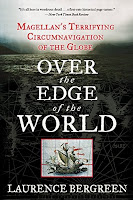The Age of Discovery did not begin and end with Columbus; there were numerous naval expeditions under that moniker continuing well into the 19th century. One of the earliest and most remarkable was Magellan's search for a westward route to the Spice Islands. His journey (1519-1522) resulted in the first, unexpected circumnavigation of the globe and proved the earth was not flat. Magellan's voyage began with a crew of 270 and 5 ships. Relatively few survived. Laurence Bergreen tells this story in Over the Edge of the World. He fills in the background of the mission and the details of the journey. It's a story of mutinies, starvation, orgies, and an epic adventure in navigational skills. Magellan's expedition changed how Europe thought of the world and how it conceived of new lands and people to conquer.
More than 350 years later, explorations were funded not by kings but by the press to give them a story. Such was the case with the voyage of the USS Jeannette, financed in large part by the New York Herald. In 1879, Captain George Washington DeLong set sail with a crew of 32 and headed toward the uncharted Arctic. At the time, there was a common belief that once a ship was past the ice, it could sail through the Bering Strait and reach navigable waters in the Arctic. Merchants would be able to sail across the North Pole. The theory proved faulty, and the Jeannette was crushed and sank. The crew took to the ice, hence the book's title, In the Kingdom of Ice. From a time of incredible, death-defying adventures, Hampton Sides vividly recreates this largely forgotten tale.
Both books promise spellbinding adventure!


No comments:
Post a Comment